Sunday was a busy day. Now that I have some time, I thought I'd crank this out.
My friend and former coworker, Nathan, used to live and work in Korea around the time I was at Sookmyung Women's University, back in my bright-eyed, bushy-tailed days.* He found love with a Korean woman who eventually became his wife; they had a son, and they've been living in the Vancouver area ever since. The son is about college age but currently doing hands-on trade work. The wife's English has improved; their half-and-half son (I can relate) has grown up speaking very little Korean. Well, the Missus and Nathan decided the time had come to revisit the Old Country; Nathan texted me about meeting up. We ended up changing the meeting day twice for various reasons, and we went from proposing to meet in the Daechi area (where I used to work) to meeting at the Seoul Museum of Art, a venue that I thought would keep us in air-conditioned comfort and out of the summer heat. Sunday's weather turned out not to be that awful: it was less wet-sponge humid than it had been, but it was still pretty hot. Nathan and I hung out at the museum for two hours before obligations called me back to my place. It was good to see Nathan again. He's an odd bird: very quiet and gentle in person, but something of a pit bull in written contexts (e.g., online forums). Nathan started off as a conservative, but he drifted left over time. Today, he and I found plenty to talk about without feeling the need to bash each other over the head with politics. So long as that sort of thing is possible, so long as people don't feel compelled to drag politics into their interactions, I can get along with almost anyone. It helps, of course, that Nathan's an actual friend.
What follows is a series of fairly random pics of our time at what Koreans call SeMA—their answer to New York City's MoMA (Museum of Modern Art). This was my first time there; I had expected to purchase tickets, but I was told that the general exhibits were free of charge, and even though the gallery struck me, overall, as rather sparse considering its huge interior volume, the walking tour proved to be a good experience. There were no arrows on the floor, and an attendant confirmed that we were free to view the exhibition rooms in whatever order we wanted. I need to read some actual literature about the place, but my impression is that SeMA leans heavily toward modern, modernistic, and postmodern art. Whenever I saw something old-school, e.g., a work reminding me of classic brush calligraphy, it was usually reworked into something modern. Among my photos is a very good example of that. Photos were permitted everywhere except for one exhibit, and that may have been the one exhibit that I most wanted to take photos of. More on that below.
Meanwhile, enjoy the parade of text and images. And do be sure to click on the link for the YouTube Short showing a view seconds of a creepy audiovisual exhibit.
 |
Nathan in the early 2000s had hair, was slim bordering on slight, and was always dressed to the nines. He's on vacation now, and he looks as if he could work as a bouncer in a bar. Despite seeming capable of throwing trees around or wrestling bears, he actually works in an office. |
 |
I told Nathan that this work, which hangs ponderously over a mezzanine in the gallery, reminded me of the surface of a pond being hit by thousands of raindrops. |
 |
This is indeed supposed to be a severed head. It was the most striking work in an exhibition area devoted to explaining the Korean War to a younger generation that has never known war. |
 |
| severed head, railing, and rebar |
 |
| Click to enlarge, see the work's title and the artist's name, and read the explanation. |
 |
I'm less cruel, these days, in my assessment of this sort of work, which no longer strikes me as random or sloppy, but as the product of an artistic vision arrived at through effort. I can't guarantee that I won't scoff at a wall-sized painting of three overlapping rectangles unjustifiably worth over a million dollars, but I can see how the above work might fit into a Korean War theme. If anything, it makes me think of a human brain's final millisecond of consciousness as shrapnel rips into it, tearing the brain and the mind to jelly. |
 |
Concertina wire, a skeleton, fall colors on the ground, Berlin Wall colors on the wall, and a sad, mottled sky... this work definitely evokes a powerful mood. |
 |
Click to enlarge and read. If that doesn't help: right-click on the image after clicking, then select "Open image in new tab." This will magnify it to its original size. The above text goes with the previous image. As you see from the ext, the wall in the picture represents the contuing north-south division. I used to think reunification was a noble goal, but over the years, I've soured on that opinion. The two Koreas are legitimately separate countries now, with utterly different cultures. I don't think reunification under either style of government would be smooth or even preferable. There are many success stories of North Koreans who defect to the South and make something of their new lives, but for every one of those stories, there are horrible accounts of Northerners who fail to adapt to the South's (relatively) freewheeling lifestyle, and these defectors fall into despair, which leads to crime, violence, or even suicide. Is reunification really worth it? What do defecting Northerners think when they go on vacation in South Korea and see the oceans of trash along the beaches and rivers, and how does this compare to their memories of a clean, spotless North Korea (even if this had been achieved through poverty and oppression)? |
The text below goes with the painting after it—the same painting I'd described above as reminiscent of a shrapnel-shredded consciousness:
 |
Note that the painting is titled Soul. So it's evoking some sort of interiority. I don't think I'm far off in my interpretation. The artist's father had died in the Korean War. |
 |
| Just showing the relationship between the text and the painting. |
 |
This work, Even After This Body Dies, was very evocative (hands usually are), but I thought the frame around the painting was entirely too pretty. I would've gone with something somber and simple. |
 |
| Great work with light and shadow. |
 |
I had to take a picture of this one, a scene depicting what the title calls a Country Lane. This strongly reminded me of any number of real-life tableaux that I walk past every time I do a cross-country trek. |
 |
| And here's the text for Country Lane (시골길/shigol-gil). |
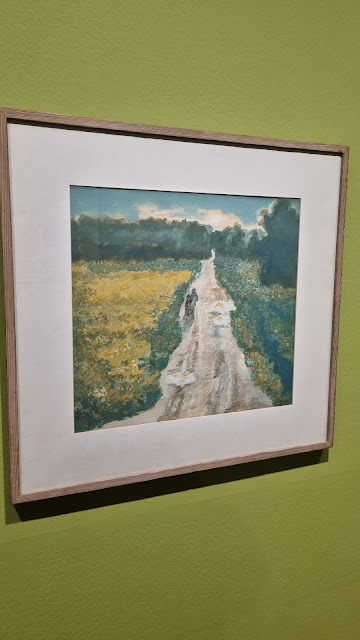 |
| more explicitly focused on the work |
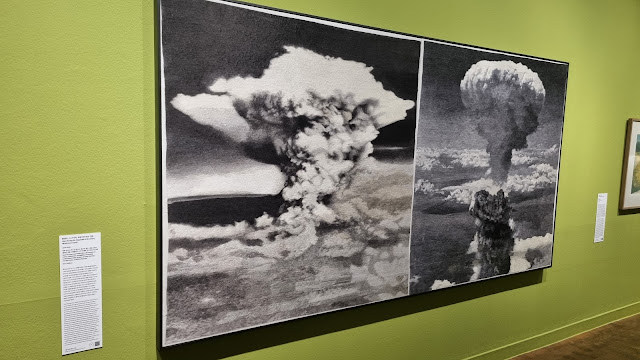 |
These are images of the Hiroshima and Nagasaki blasts that ended World War II in the Asian theater. At first, I thought this felt too much like gloating, but this is directly relevant to the issue of the Japanese occupation of Korea. Japanese occupation ended at the end of World War II. |
 |
| Click for an explanation of the images and the art. |
 |
| Hiroshima... |
 |
| ...and Nagasaki. (I feel like Johnny Somali.) |
 |
| This work seems incongruously pretty until you look more closely. See the hands and the guns? |
 |
| See the hands and the guns now? |
 |
| The above work is titled Angel Soldier_Photo 01. Click for the explanation. |
 |
| This explanation applies to the work below. |
 |
The artist is a former soldier and pro-unification partisan interpreting what it was like to see the DMZ landscape through night-vision goggles. I'm moved, but I disagree with his stance. |
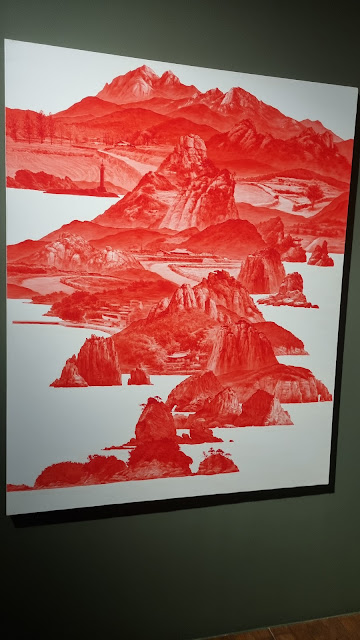 |
| Let the image speak for itself. |
 |
| Definitely not subtle, but the materials make sure the work evokes glory. |
 |
| As you'll see below, the title is Korean Peninsula: Light. |
 |
| Click for explanation. |
 |
This is the supreme example, in this gallery, of the use of old-school techniques to produce something more modern. These are Chinese characters (hanja) composed of little human figures, each drawn with a good, old calligraphy brush on good, old calligraphy paper (hwaseonji). As you'll see in the explanation below, this is called Anti-war Peace. I assume this is another subtle or unsubtle call for laying aside arms and embracing unification, but I think I'm out of step with this generation. One thing I no longer am is an idealist about the two Koreas' ever smoothly becoming one. I see the character for "peace" (平, 평, pyeong) in the image—center right. Together, 平和/평화/pyeonghwa mean "peace and harmony." I think that's a hwa (harmony) at the bottom right of the image. You definitely need to blow this image up to appreciate the painstaking detail. The message is as subtle as a freight train: you can't have peace without people. The dark implication is that, when there are no people, what you have isn't peace: it's just silence. The rest is silence. |
 |
| Click to read the explanation. |
Below is the only photo I was able to take of this next gallery, an exhibition dedicated to the work of artist Cheon Gyeong-ja (Chun Kyung-ja). I learned a lot about Cheon as I slowly took in her various works and crawled into her brain. Like most artists, she went through phases. Her style sometimes had a lot in common with that of Frida Kahlo—strong colors, bold contrasts, firm and explicit lines. But she also did a lot with water color, and some of her sketches and book-cover art were featured in the exhibit as well. She had obviously traveled all over the world because many of her works strikingly portray people of different ethnicities, and she wasn't confined to studying just people and animals, either: she was fascinated by place, as could be seen in works where people were only a minor feature in favor of grander objects like buildings or natural terrain. In the States, she had visited the American Southwest (Monument Valley) and New Orleans; she'd been to India, Thailand, and the Caribbean as well. One of her paintings, with a title like Invocation of the Spirit of the Dead or something (found a pic of it), would have looked to me like a biblical scene (people on a boat before someone walks on water) had it not been for a creepy, writhing angel/spirit (reminiscent of "Raiders of the Lost Ark") plus, as Nathan mentioned, a dead fish in the foreground reminding us that memento mori isn't just for the human world. Read more about Cheon here.
 |
| Too bad this exhibit didn't allow photos. |
We're back out in the museum's main space, now; the museum is several floors tall.
 |
| plenty of places to sit |
 |
| a wider shot |
Here's a link to a YouTube Short of a creepy exhibit that was as much auditory as it was visual. I wrote a nice description for it, which I hope you'll read.
Nathan and I went into a much more interactive space where regular folks could pick up chalk and add to a wall-sized display. At a long table fit for Vikings home from a day of plundering was a different setup for regular folks: you could draw ditties on pieces of paper and add to an ever-growing collection of mini-artworks by normal citizens. Nathan and I added our works. Mine wasn't anything more than a series of familiar go-to images I've drawn for years; Nathan's series of images described something like a spiritual progression from turmoil and conflict to a current state of peace and cosmic perspective. Below is a shot of Nathan, the chalk wall, and the drawing table:
 |
| We are all slaves to our phones. There is no hope of escape. |
 |
| the invitation/challenge to draw something and leave it |
 |
| I do like this sort of randomly collaborative art. It's orderly in its own way, unlike the chaos of the chalk wall. |
 |
From L to R, Nathan goes from turmoil to a serene, cosmic perspective. Yes, that's the SS lighting-bolt symbol, which shows you what a dark place Nathan had been in. And no, Nathan's not a Nazi. |
 |
Anyone who's followed me for some time has seen all of the above images in some form or other. Nathan wasn't able to figure out the tiger/rabbit one, which was, admittedly, pretty poorly drawn. But in my defense: the tiger is large (so it's not a house cat), fanged, and even striped. So there are definitely clues! And the rabbit has long ears and buck teeth, like Bugs Bunny. Come on, Nathan! The bad Chinese says Seon Bulgyo (禪佛敎/선불교), or "Zen Buddhism." That's why Bodhidharma (Dalma-daesa) is on the right. That's my happy, coked-up dragon on the left, with clouds, holding the standard 여의주/yeouiju (jewel symbolizing divine power and authority). In the end, though, Nathan's work tells a story and is more profound. Mine is just a jumble of randomness. |
 |
| our two pics together |
 |
| There was art along the walls of this large space as well. This art is a slab (or many slabs?) of wood. |
 |
| Click and read the explanation. |
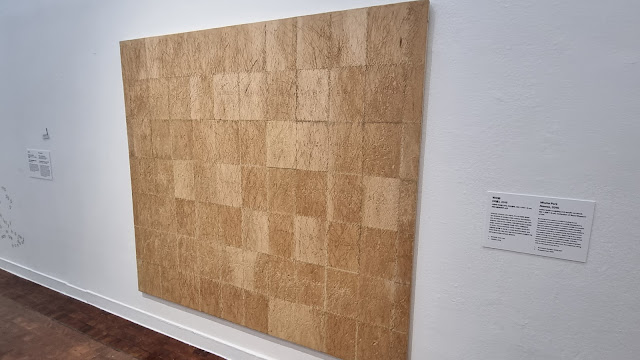 |
| the postmodern pastiche in action |
 |
| Photos of hand-shaped tumors? |
 |
| Nathan stoops to examine the tumors. |
 |
I can get behind the sentiment. I've long thought the EU was a mistake. Europe isn't ready for such integration, hence Brexit and the calls for Frexit, Polexit, etc. |
 |
| I've taken photos a bit like these. Maybe I should do my own exhibition. |
 |
| If this is irony, I'm not getting it. I did see, though, that this is a frame from a video. |
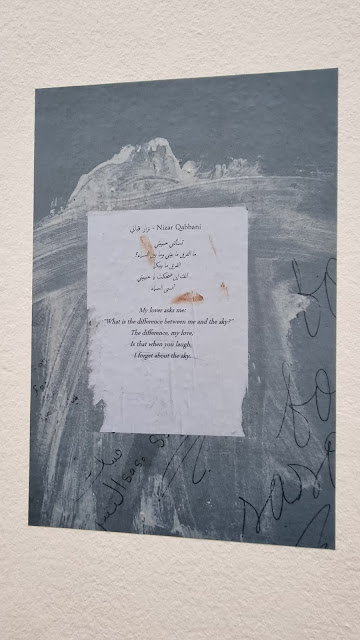 |
| I suggested to Nathan that this would be a nice poem to give to his wife. |
Nathan came to Korea with his wife, but his son was unable to make it.
 |
| Awwwww. |
 |
| Growing old together, but hopefully not so miserably. |
 |
| a shot of the mezzanine from the third floor |
Nathan and I sat down for forty minutes and just talked. We caught up on his family life and my medical problems; he reminded me of the epic of Gilgamesh, a story with which I'm only passingly familiar, as we covered the topic of death and afterlife, and how we "live on" even if there's no literal continuation of consciousness after death. There was some mention of Buddhism and Jainism. Before we left SeMA, I adjourned to the restroom, where I saw this rather sophisticated sign in my toilet cubicle:
 |
(large, red font) "Absolutely forbidden to throw foreign objects in toilet bowl." (smaller font, asterisked) "Wet wipes, feminine products, 'hand towels' (paper towels, I assume, not washcloths), etc. Aside from toilet paper, please throw other objects in the trash can." These restroom signs (in honor of Nathan's Canuck heritage, I should call them washroom signs) vary depending on location: some call for never throwing anything into the toilet bowl, not even dung-covered paper, because the toilets block up too easily. Other cubicles have no wastepaper baskets in them, and those cubicles will have signs saying to throw your toilet tissue into the toilet. When in Rome, I guess. The rules are different wherever you go. |
Nathan took the subway back to wherever he's staying. He and his wife will leave Korea on Tuesday. I elected to grab a taxi, not wanting to deal with subway stairs, which had caused me a bit of heart trouble on the way to the museum from my place in southeast Seoul. Lots and lots of stairs. Followed by a gentle uphill walk to the museum. I'll be seeing my cardiology doc on July 9, so I'll ask him what can be done, if anything.
The shot below was taken from inside my taxi; the tree has nothing to do with the art museum. But as I've said many times, Koreans love their abstract art. I'm convinced that the East Asian partiality to abstraction has everything to do with how East Asians process language. Chinese characters have been subdivided into six subtypes, among which are pictograms and ideograms—i.e., abstract representations of real objects and/or practical concepts. Koreans have been primed for abstractness for centuries. And since so much Muslim art is geometric in nature (in some Muslim sectors, artists are never supposed to depict living things since the gift of life belongs solely to Allah), many Muslims, too, are primed to appreciate abstractions.
 |
| Do you get the impression that this tree lights up at night? That would be tacky. |
Morning bled into early afternoon, and Nathan and I went our separate ways. He's got one more family gathering coming up, then he and his wife leave Korea on Tuesday to return to their humidity-less idyll in Canada. Some guys have all the luck.
__________
*I didn't know it back then, but Sookmyung, my mother's alma mater, turned out to be a great introduction to the world of university-level teaching. It had its bad moments and its bullshit, as is true of all jobs, but back then, I had come from a hagweon background, working split shifts and occasional weekends, so I really appreciated the two months a year that I got for vacation: July and January. As I found out later, regular university work normally gives you four months' vacation, but back then, I was a newbie who didn't know any better. That said, working at the Golden Goose—where I'd take a single month off for my long walks—taught me to appreciate long blocks of yearly vacation, whether that might mean four months, two months, or just one month.
ADDENDUM: Cheon Gyeong-ja's 1965 Invocation of the Spirit of the Dead:



























































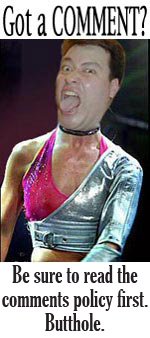

Looks to have been a great day, glad you got some time with an old friend. Lots of variety at the museum. Trying to remember the last time I visited one...either the War Museum in Yongsan or the American History museum in DC.
ReplyDeleteIs he still into coins?
ReplyDeleteYes, he is. I kept pressing him to write a book. I think he could find a good market for it. And he's a really good writer.
DeleteGreat write-up and photography, Kevin! It was wonderful to see you again after all these years, and you picked a good location to do that in.
ReplyDeleteYour comment about the pitbull in written contexts made me smile as I have often thought the same thing of you. Like the New Testament Paul, your in-person manner is much milder than your written work. I guess that can be true of me as well, although in the last year or so I think I have really mellowed online as well. Partly that's been forced as I am practicing self-censorship. But partly it's because I feel I often see diminishing returns from online political debates.
In any case, we do indeed have very different views of politics, but I think that we both still have good hearts. 😅
The bullet head artwork is a powerful one. It's so stark and sad. I also see something rather phallic about it. It's as though the entirety of what it can mean to be human has been abbreviated, truncated, twisted, put into a straightjacket, dismembered, and destroyed. It's so sad.
I do have a question. I think I understand you to write that the older generation is more skeptical of unification. I always thought it was the opposite.
Regarding the participatory artwork that we did, I have a few comments. First, my sincerest apologies regarding the rabbit! I can clearly see the rabbit and the tiger now. I think when I was in the gallery, I was simply on the wrong angle.The SS symbol for me was basically a way of referencing the human propensity for destruction and great suffering. (I've always been as anti-Nazi as they come. But the cruelty of the SS in particular has been on my mind lately due to my history reading.)
I have come through some very dark places as a person with experience with depression. Nowadays, I feel so much better.
My third panel had a note of caution and fear in the reference to the poem "On Wenlock Edge" (set to music so wonderfully by Ralph Vaughan Williams!). I had intended a counterpoint to it with the two hands reaching for a handshake, but I think at least one of them looks like some sort of claw! Oh well.
Have a great week, my friend. Take care and let's continue to keep in touch.
Regarding this:
DeleteI do have a question. I think I understand you to write that the older generation is more skeptical of unification. I always thought it was the opposite.
Yes, I think you're right: it's the younger generation that's more skeptical of reunification, and I was trying to say that I feel out of step with the older generation, i.e., the pro-reunification crowd. Reunification is a pipe dream.
re: SS
Nobody who met you would ever mistake you for a Nazi.
Thanks for the "On Wenlock Edge" explanation. It was good to see you again, too. Take care!